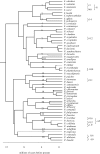The roles of time and ecology in the continental radiation of the Old World leaf warblers (Phylloscopus and Seicercus)
- PMID: 20439279
- PMCID: PMC2871886
- DOI: 10.1098/rstb.2009.0269
The roles of time and ecology in the continental radiation of the Old World leaf warblers (Phylloscopus and Seicercus)
Abstract
Many continental sister species are allopatric or parapatric, ecologically similar and long separated, of the order of millions of years. Sympatric, ecologically differentiated, species, are often even older. This raises the question of whether build-up of sympatric diversity generally follows a slow process of divergence in allopatry, initially without much ecological change. I review patterns of speciation among birds belonging to the continental Eurasian Old World leaf warblers (Phylloscopus and Seicercus). I consider speciation to be a three-stage process (range expansions, barriers to gene flow, reproductive isolation) and ask how ecological factors at each stage have contributed to speciation, both among allopatric/parapatric sister species and among those lineages that eventually led to currently sympatric species. I suggest that time is probably the critical factor that leads to reproductive isolation between sympatric species and that a strong connection between ecological divergence and reproductive isolation remains to be established. Besides reproductive isolation, ecological factors can affect range expansions (e.g. habitat tracking) and the formation of barriers (e.g. treeless areas are effective barriers for warblers). Ecological factors may often limit speciation on continents because range expansions are difficult in 'ecologically full' environments.
Figures






Similar articles
-
Build-up of the Himalayan avifauna through immigration: a biogeographical analysis of the Phylloscopus and Seicercus warblers.Evolution. 2007 Feb;61(2):324-33. doi: 10.1111/j.1558-5646.2007.00024.x. Evolution. 2007. PMID: 17348943
-
Patterns of gene flow and selection across multiple species of Acrocephalus warblers: footprints of parallel selection on the Z chromosome.BMC Evol Biol. 2016 Jun 16;16(1):130. doi: 10.1186/s12862-016-0692-2. BMC Evol Biol. 2016. PMID: 27311647 Free PMC article.
-
Niche filling slows the diversification of Himalayan songbirds.Nature. 2014 May 8;509(7499):222-5. doi: 10.1038/nature13272. Epub 2014 Apr 30. Nature. 2014. PMID: 24776798
-
Speciation in Daphnia.Mol Ecol. 2021 Mar;30(6):1398-1418. doi: 10.1111/mec.15824. Epub 2021 Mar 1. Mol Ecol. 2021. PMID: 33522056 Review.
-
Ecological speciation in marine v. freshwater fishes.J Fish Biol. 2009 Oct;75(5):960-96. doi: 10.1111/j.1095-8649.2009.02358.x. J Fish Biol. 2009. PMID: 20738594 Review.
Cited by
-
Potential merger of ancient lineages in a passerine bird discovered based on evidence from host-specific ectoparasites.Ecol Evol. 2015 Sep;5(17):3743-55. doi: 10.1002/ece3.1639. Epub 2015 Aug 18. Ecol Evol. 2015. PMID: 26380702 Free PMC article.
-
Learning and signal copying facilitate communication among bird species.Proc Biol Sci. 2013 Feb 27;280(1757):20123070. doi: 10.1098/rspb.2012.3070. Print 2013 Apr 22. Proc Biol Sci. 2013. PMID: 23446529 Free PMC article.
-
Expansion in geographical and morphological space drives continued lineage diversification in a global passerine radiation.Proc Biol Sci. 2018 Dec 19;285(1893):20182181. doi: 10.1098/rspb.2018.2181. Proc Biol Sci. 2018. PMID: 30963909 Free PMC article.
-
Most Genomic Loci Misrepresent the Phylogeny of an Avian Radiation Because of Ancient Gene Flow.Syst Biol. 2021 Aug 11;70(5):961-975. doi: 10.1093/sysbio/syab024. Syst Biol. 2021. PMID: 33787929 Free PMC article.
-
Evolution and stability of ring species.Proc Natl Acad Sci U S A. 2013 Mar 26;110(13):5080-4. doi: 10.1073/pnas.1217034110. Epub 2013 Mar 11. Proc Natl Acad Sci U S A. 2013. PMID: 23479635 Free PMC article.
References
-
- Alström P., Olsson U.1992Taxonomic status of Phylloscopus affinis and P. subaffinis. Bull. Brit. Orn. Club 112, 111–126
-
- Alström P., Olsson U.1993Blyth's leaf warbler Phylloscopus reguloides found breeding in Thailand. Forktail 9, 150–152
-
- Alström P., Olsson U.1995A new species of Phylloscopus warbler from Sichuan Province, China. Ibis 137, 459–468 (doi:10.1111/j.1474-919X.1995.tb03254.x) - DOI
-
- Alström P., Olsson U.1999The golden-spectacled warbler: a complex of sibling species, including a previously undescribed species. Ibis 141, 545–568 (doi:10.1111/j.1474-919X.1999.tb07363.x) - DOI
-
- Alström P., Olsson U., Colston P. R.1992A new species of Phylloscopus warbler from central China. Ibis 134, 329–334 (doi:10.1111/j.1474-919X.1992.tb08011.x) - DOI
Publication types
MeSH terms
LinkOut - more resources
Full Text Sources

